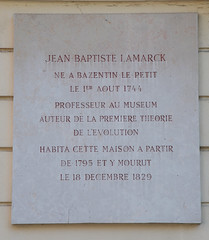Professor Jean-Baptiste Lamarck


Professor Jean-Baptiste Lamarck
(1744-1829)
Commemorated on 1 plaque
Jean Baptiste Lamarck ne a Bazentin-le-Petit le 1er aout 1744 Professeur au museum Auteur de la premier theorie de l'evolution habita cette maison a partir de 1795 et y mourut le 18 Decembre 1829
English translation: Jean Baptiste Lamarck did Bazentin-le-Petit on August 1, 1744 Professor at the museum Author of the first theory of evolution inhabited this house from 1795 and died there on December 18, 1829 [AWS Translate]
26 rue Buffon, in the Jardin des Plantes, Paris, France where they lived (1794)

